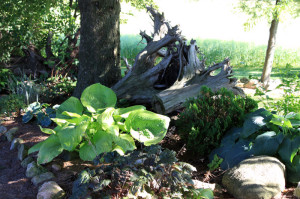It’s Still Just Dirt, January 2014
by Penny Esseltine
 Nothing beats winter more than the promise of warm weather ahead and that’s just what Lynn Bisschop brought to the January Tillsonburg Horticultural Society gathering with her presentation on Hostas. Lynn owns Shades of Green Hostas, a garden centre just south of Aylmer.
Nothing beats winter more than the promise of warm weather ahead and that’s just what Lynn Bisschop brought to the January Tillsonburg Horticultural Society gathering with her presentation on Hostas. Lynn owns Shades of Green Hostas, a garden centre just south of Aylmer.
Lynn tells us that there are 43 species of hostas and from these there are now more than 8,000 different varieties. Hostas are native to Japan, Korea and China. Lynn says they can survive in a variety of habitats including woodlands, marshes, grasslands and near rivers and streams. “Hostas are shade tolerant,” she says, “but that doesn’t mean deep dark back of the garden shade”. Generally full sun to part shade suits them fine.
Hostas can be propagated by division or by tissue culture in a lab. “The odds of mutations are much higher with tissue culture,” Lynn says, but tissue culture provides the means to keep up with gardeners’ increasing demands for hosta plants. Some hostas are more difficult to propagate than others and that’s when the cost goes up. Lynn says she has spent 10 years working at splitting a hosta called Gunther’s Prize. She says it’s a difficult one.
Gardeners use interesting terms to describe hostas. Leaves can be wavy or bumpled, rippled or seer-suckered. Flowers can be tubular or bell-shaped in shades of lavender and white. Stems are called legs. But it’s in naming different varieties that word play really shines.
From the species called Sagae a family has grown to include varieties like Big Hobber, Clifford’s Forest Fire, Fat Cat, Kiwi Skyscraper and Liberty. From Blue Mouse comes Mouse Ears, Itty Bitty, Church Mouse, Mouse Trap, Mighty Mouse, and many, many more.
Blue Angel is a great big blue hosta that can measure seven feet across. Beckoning is like Blue Angel but the centre goes yellow. Earth Angel’s margins are yellow. With Guardian Angel the centre is misted.
The names of hostas that have been derived from Striptease are especially fun. There’s Lady Godiva, Full Monty, Gypsy Rose, Yellow Polka Dot Bikini, Risky Business and again, a whole lot more.
A hosta called June is one of the most popular hostas year after year, and Empress Wu is touted to be the biggest in size. Both Elvis and Stephen King have hostas named for them. Lynn says one of her favourites is Heavenly Tiara which is green with a wide white margin and it comes from a line that includes Golden Tiara, Diamond Tiara and Diamonds are Forever.
If you would like to see for yourself what any of these hosta look like visit Lynn’s website at www.shadesofgreenhostas.ca. Photos are displayed alphabetically and the chance of you finding the hosta you are looking for is extremely good.
The Hosta of the Year for 2014 is called Abiqua Drinking Gourd. It’s a dark blue-green hosta with seer-suckered leaves that form deeply cupped foliage. It’s medium sized, about 22” high and 46” across. Near white flowers bloom in mid summer.
In other hosta news, the Ontario Hosta Society will be holding its annual one-day Hosta Forum on Sunday, April 6 at the Glencairn Golf Club in Halton Hills. For info about this visit their website at www.ontariohostasociety.com.
And speaking of websites, be sure to check out the totally revamped Tillsonburg Horticultural Society website at tillsonburghorticultural.ca.
Take the Yawn Out of Your Lawn is up next when the Tillsonburg Horticultural Society meets on Tuesday, February 4 at 7:30 p.m. in the Senior Centre Auditorium at the Tillsonburg Community Centre. Our guest speaker is Jim Galbraith from the University of Western Ontario. An annual society membership costs $15 and it’s just $2 for non-members to attend each meeting. Everyone is welcome.